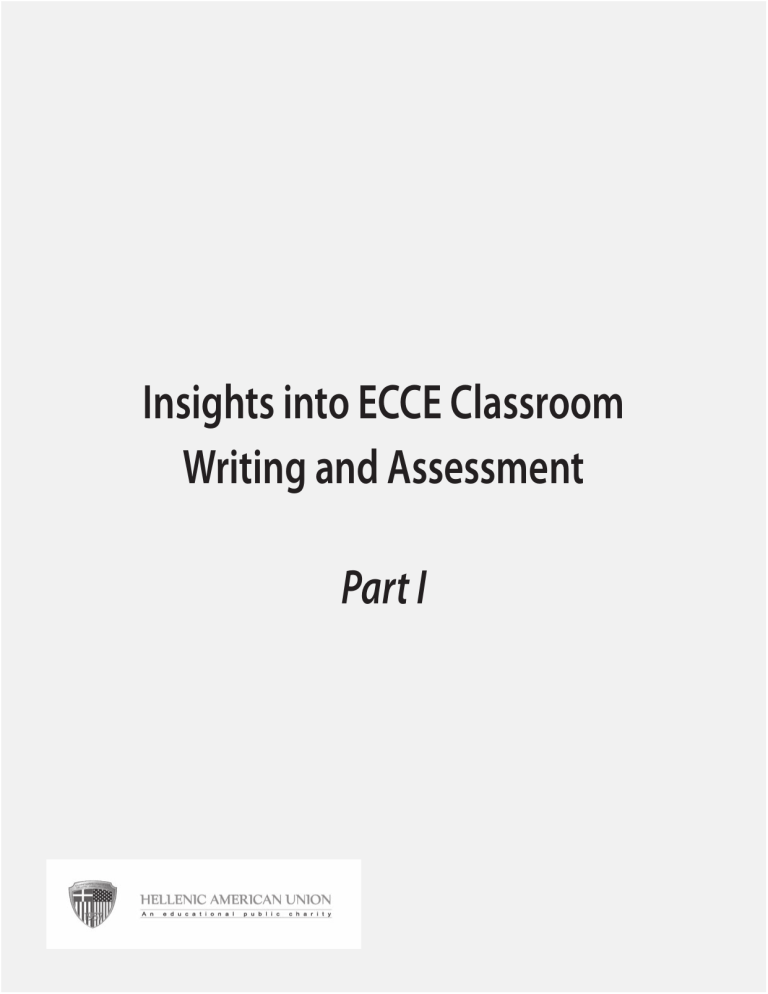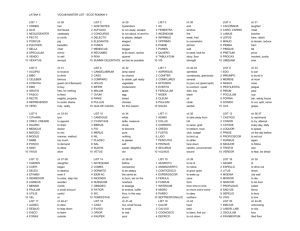Insights into ECCE Classroom Writing and Assessment Part I
advertisement

Insights into ECCE Classroom Writing and Assessment Part I Insights into ECCE Classroom Writing and Assessment, Part I Hellenic American Union, March 2007 Contents In-Class Writing and Assessment 3 How to use ELI-UM Benchmarked Letters and Writing Section Scoring Rubric 4 ECCE Sample Letters Benchmarked by ELI-UM 6 THE UNIVERSITY OF MICHIGAN EXAMINATION FOR THE CERTIFICATE OF COMPETENCY IN ENGLISH (ECCE) IN-CLASS WRITING AND ASSESSMENT In-class Writing In order for candidates to receive at least a Low Pass (LP) on the ECCE Writing Section, they need to be able to do the following (Level C descriptors on the ELI-UM Scoring Scale): • adequately develop an argument (content and development) • convey their ideas clearly, which should be adequately organized, using standard connectors appropriately though somewhat mechanically (organization and connection of ideas) • use a sufficient range of grammar and vocabulary to fulfill the task though they may make errors in grammar or vocabulary that do not interfere with reader’s comprehension (linguistic range and control) • display an adequate sense of audience and purpose for writing, generally allowing the reader to follow their text (communicative effect) Students’ preparation for this section of the ECCE examination should be systematic and incorporate intensive as well as extensive reading of a wide variety of texts, close examination and analysis of model letters and essays, as well as ample writing practice both in-class and at home. In class-writing will give students the opportunity to practice, consolidate and further develop their writing skills as well as learn the process of writing (i.e. brainstorming, outlining, writing drafts, editing, etc.), an invaluable life-skill. Besides giving the EFL teacher an idea of their students’ progress, in-class writing also gives students training in making effective use of the writing time set by ELI-UM (30 minutes). On the other hand, at home writing helps students apply the knowledge they gain in the classroom allowing them, however, to work at their own pace and to make use of various resources (e.g. dictionaries, the Internet, etc.) ECCE Writing Assessment An important stage of the ECCE Writing Section preparation is assessment. Students should be made aware of what successful writing is at ECCE level (B2 on the CEFR) by becoming thoroughly familiar with the ELI-UM Writing Section scoring scales and descriptors. Familiarization with the scoring criteria will make students more aware of their strengths and weaknesses and will help them focus more on the areas they need to further develop. The attached ECCE candidates’ letters have been benchmarked by the English Language Institute at the University of Michigan and are distributed by the Hellenic American Union to language school owners and EFL teachers free of charge. Insights into ECCE Classroom Writing and Assessment, Part I Hellenic American Union, March 2007 HOW TO USE ELI-UM BENCHMARKED LETTERS & WRITING SECTION SCORING RUBRIC IN THE CLASSROOM Objectives: • • To give students insight into ECCE level writing To familiarize students with the ECCE Writing Section scoring criteria and levels Time: Approximately three hours for all five stages. All stages could be done on one session. Alternatively, the stages could be done on three consecutive sessions (Stages 1 & 2 first, then Stages 3 & 4, and Stage 5 on the third session). STAGE 1: Preparing to write a letter. Understanding the prompt and the letter-writing task, understanding the focus question and brainstorming on the topic. Step 1: Understanding the prompt: Teacher selects one of the prompts of the ELI-UM benchmarked letters and asks students to read it carefully. Students should be encouraged to underline key language in order to ensure thorough understanding of the prompt. The ECCE Writing prompt provides important information on who is writing the letter (e.g. local citizens, readers of a magazine, local community members, etc.), to whom (e.g. the editor of a magazine, the Ministry of Education, the City Library, etc.) and why (e.g. to express their agreement or disagreement with the library’s decision to buy computers with internet access instead of reading books, to make suggestions on how to use the money to improve local schools, to express their opinion on the kinds of advertisements a magazine should use, etc.). Once students have read the prompt, the teacher should ask the students to tell the class in their words what the prompt is about. Step 2: Understanding the task: Teacher should ask students to read the letter-writing task (Task A). Students should be asked to underline key language and then tell the class in their own words whom they have to write their letter to as well as what kind of letter they are required to write (e.g. letter expressing their opinion or letter of suggestion which may require describing a project, etc.) Step 3: Understanding the focus question and brainstorming on the topic: Teacher should ask students to reread the focus question and brainstorm on how they would answer it. Teacher should then work with the class as a group to elicit ideas, suggestions, arguments and examples. With the teacher’s assistance students should then select the best ideas, which can be written on the blackboard. Step 4: Eliciting and/or providing topic-related vocabulary: Teacher should also try to elicit important topicrelated vocabulary. Teacher should provide any unknown vocabulary and write it on the blackboard. At the same time, students should be encouraged to also think of synonyms so that they can avoid repetition of words or expressions in the letter they will have to write during the second stage. Step 5: Brainstorming on how to organize the letter and creating an outline: Teacher should ask students to work in pairs to decide how they will organize their letter. In other words, students should decide in pairs how many paragraphs the letter should have and what needs to be included in each paragraph (introduction, main body and conclusion) and create an outline (either mental or written). Step 6: Class discussion on the organization of the letter: Students should work as a class to exchange ideas about the organization of the letter. Teacher should confirm or reject students’ decisions, providing justification and explanations. The final outline of the letter should be written on the blackboard. Step 7: Organizing ideas within each paragraph: Teacher should discuss with the class as a whole how they should organize their ideas within each one of the paragraphs (i.e. topic sentences, supporting statements and examples, for the main body). Insights into ECCE Classroom Writing and Assessment, Part I Hellenic American Union, March 2007 STAGE 2: In-class writing. Students write their letter individually or in pairs. Step 1: Writing the letter in class without teacher assistance: Students should be asked to write the letter inclass working individually or in pairs. Students should work on the topic that has been discussed in Stage One. They should be asked to write their letter in 30 minutes, just as they would on the actual test. STAGE 3: Students become familiar with and learn how to use the ECCE Writing Criteria. Step 1: Understanding the ELI-UM writing criteria: Teacher should help students understand the differences between the various bands (A, B, C, D, and E). Teacher should give students a copy of the ELI-UM scoring scales, ask them to work in pairs and underline important differences between the five bands, and then provide feedback and explanations. Teacher should go over all the bands very carefully. Step 2: Rating the letter using the ELI-UM writing criteria: Teacher should give students a copy of the benchmarked letters without the highlighted parts and comments by ELI-UM. Students should work in pairs to rate the letters using the ELI-UM scoring criteria. Teacher should assist students as they are doing this. Step 3: Justifying assigned rating: Teacher should work with the class as a group. Each pair should report to the rest of the class, giving the rating they have assigned and justifying their rating (A, B, C, D, or E) by referring to the ELI-UM scoring criteria. Step 4: Confirming assigned rating: Teacher should give students the benchmarked essays with the highlighted parts and the ELI-UM comments so that they can compare their ratings and justifications with those provided by ELI-UM. STAGE 4: Students compare their letter with ELI-UM benchmarked letters. Step 1: Comparing in-class letters with benchmarked ones: Teacher should ask students to exchange letters and to compare the letter of another student or pair with the one(s) benchmarked by ELIUM. Students should be asked to compare the letters in terms of organization, linguistic range and control, communicative effect and content and development. Step 2: Grading the letter: Students should grade their classmates’ letter(s) and justify the rating they have assigned, referring to the ELI-UM scoring criteria. STAGE 5: Students edit their classmates’ letters with their teacher’s assistance. Step 1: Editing organization of ideas: Students should be asked to edit their classmates’ letter(s), focusing only on organization and connection of ideas. Step 2: Editing content and development: Students should be asked to edit the letter(s), focusing this time on communicative effect and content and development. Step 3: Editing language: In this step, students should focus on linguistic range and control, checking and editing grammatical or syntactical errors, or errors in vocabulary use. Insights into ECCE Classroom Writing and Assessment, Part I Hellenic American Union, March 2007 ExCEEdS STANdARd STANdARd BElOW STANdARd Appropriate and clear organization and connection of ideas. Transition markers used appropriately and not mechanically. Ideas clearly and adequately organized. Standard connectors used appropriately but somewhat mechanically. Simple, basic organization of ideas. Although standard connectors may be present, ideas themselves are not always connected. Minimal or no organization. Connectors may be inappropriately used. Connection may not be apparent. Fully develops an argument with appropriate supporting details. Adequately develops an argument. May rely on prompt for content. Inadequate development of argument. Content may be limited or primarily based on prompt. Some content may be irrelevant to the topic. Little or no development of argument. Content is irrelevant or taken directly from the prompt. A B E d C Smooth, effective arrangement and connection of ideas. A variety of cohesive devices are used effectively. Richly develops an argument with original supporting details. • Arrangement of content • How language is used to link ideas ORGANIzATION ANd CONNECTION OF IdEAS Lacks audience awareness and purpose for writing. Grammar and vocabulary errors predominate and cause significant confusion. Adequate sense of audience and purpose for writing generally allow the reader to follow the text. Sufficient range of grammar and vocabulary to fulfill the task. Errors in grammar and vocabulary do not interfere with reader’s comprehension. Some misunderstanding of audience and purpose and inappropriate register may have a negative effect and hinder the reader’s comprehension of the text. Appropriate register, awareness of audience, and establishment of context help the reader to follow the text. Good range of grammar and vocabulary; mostly accurate with only occasional errors. A range of structures may be attempted, but grammar and vocabulary errors are frequent and interfere with reader’s comprehension. Appropriate register, awareness of audience, and establishment of context fully enhance the intended effect on the reader. • How well communicative goals are achieved COmmuNICATIvE EFFECT Broad range of grammar and vocabulary used accurately. If any errors are present they are minor and insignificant. • Variety and precision of grammar and vocabulary lINGuISTIC RANGE ANd CONTROl SCORING CRITERIA FOR ECCE WRITING SECTION • Relevance of content to task • Quality of ideas used to develop the response CONTENT ANd dEvElOpmENT ELI-UM Insights into ECCE Classroom Writing and Assessment, Part I Hellenic American Union, March 2007 Insights into ECCE Classroom Writing and Assessment, Part I Hellenic American Union, March 2007 Insights into ECCE Classroom Writing and Assessment, Part I Hellenic American Union, March 2007 10 Insights into ECCE Classroom Writing and Assessment, Part I Hellenic American Union, March 2007 Insights into ECCE Classroom Writing and Assessment, Part I Hellenic American Union, March 2007 11 12 Insights into ECCE Classroom Writing and Assessment, Part I Hellenic American Union, March 2007 Insights into ECCE Classroom Writing and Assessment, Part I Hellenic American Union, March 2007 13 14 Insights into ECCE Classroom Writing and Assessment, Part I Hellenic American Union, March 2007 Insights into ECCE Classroom Writing and Assessment, Part I Hellenic American Union, March 2007 15


